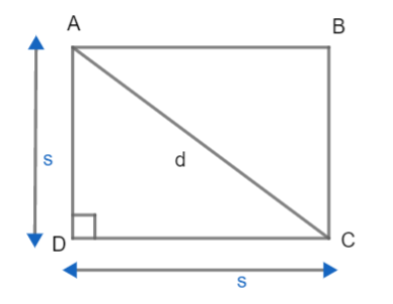
If the area of a square is $32c{{m}^{2}}$ then find the diagonal of the square.
\[\begin{align}
& A.8cm \\
& B.4\sqrt{2}cm \\
& C.8\sqrt{2}cm \\
& D.4cm \\
\end{align}\]
Answer
556.5k+ views
Hint: In this question, we are given the area of a square and we need to find the diagonal. For this, we will first find the side of the square using the formula of the area of square given by, $\text{Area of the square}=\text{side}\times \text{side}={{\left( \text{side} \right)}^{2}}$. After that, we will use Pythagoras theorem to calculate the diagonal of the given by ${{\left( \text{Hypotenuse} \right)}^{2}}={{\left( \text{Base} \right)}^{2}}+{{\left( \text{Perpendicular} \right)}^{2}}$.
Complete step by step answer:
Here we are given the area of the square as $32c{{m}^{2}}$. We need to find the length of the diagonal of the square. Let us suppose the side of the square as s and the diagonal of the square as d. Our figure looks like this:

Now let us find the side of the square. As we know that, the area of the square is given by $A={{s}^{2}}$ so we get:
$32={{s}^{2}}\Rightarrow s=\sqrt{32}cm$.
Hence the side of the square is $\sqrt{32}cm$.
Now we need to find the value of d.
As we know, every angle in a square is ${{90}^{\circ }}$. So we can say from the figure that triangle ACD is a right angled triangle. Therefore we can use Pythagoras theorem in triangle ACD. Pythagoras theorem is given as:
${{\left( \text{Hypotenuse} \right)}^{2}}={{\left( \text{Base} \right)}^{2}}+{{\left( \text{Perpendicular} \right)}^{2}}$.
In $\Delta ACD$ we have, ${{\left( \text{AC} \right)}^{2}}={{\left( \text{CD} \right)}^{2}}+{{\left( \text{AD} \right)}^{2}}$.
From figure we can see that AC = d, AD = DC = s, so we get:
${{\left( \text{d} \right)}^{2}}={{\left( \text{s} \right)}^{2}}+{{\left( \text{s} \right)}^{2}}\Rightarrow {{\text{d}}^{2}}=2{{\text{s}}^{2}}$.
Now as found earlier the value of s is $\sqrt{32}cm$. Hence we get:
${{d}^{2}}=2{{\left( \sqrt{32} \right)}^{2}}\Rightarrow {{d}^{2}}=2\times 32\Rightarrow {{d}^{2}}=64$.
Taking square roots both sides we get:
$d=\sqrt{64}\Rightarrow d=8$.
Hence the length of the diagonal of the square is 8cm.
So, the correct answer is “Option A”.
Note: Students should always try to draw diagrams for better understanding. Make sure to use proper units with area, length. We use squared units for area. Since a square has both diagonal equal so we can take any triangle and find any diagonal. Students can also learn a shortcut formula to find diagonal of the square given as: Diagonal of the square $\Rightarrow \sqrt{2}\times \text{side}$.
Complete step by step answer:
Here we are given the area of the square as $32c{{m}^{2}}$. We need to find the length of the diagonal of the square. Let us suppose the side of the square as s and the diagonal of the square as d. Our figure looks like this:

Now let us find the side of the square. As we know that, the area of the square is given by $A={{s}^{2}}$ so we get:
$32={{s}^{2}}\Rightarrow s=\sqrt{32}cm$.
Hence the side of the square is $\sqrt{32}cm$.
Now we need to find the value of d.
As we know, every angle in a square is ${{90}^{\circ }}$. So we can say from the figure that triangle ACD is a right angled triangle. Therefore we can use Pythagoras theorem in triangle ACD. Pythagoras theorem is given as:
${{\left( \text{Hypotenuse} \right)}^{2}}={{\left( \text{Base} \right)}^{2}}+{{\left( \text{Perpendicular} \right)}^{2}}$.
In $\Delta ACD$ we have, ${{\left( \text{AC} \right)}^{2}}={{\left( \text{CD} \right)}^{2}}+{{\left( \text{AD} \right)}^{2}}$.
From figure we can see that AC = d, AD = DC = s, so we get:
${{\left( \text{d} \right)}^{2}}={{\left( \text{s} \right)}^{2}}+{{\left( \text{s} \right)}^{2}}\Rightarrow {{\text{d}}^{2}}=2{{\text{s}}^{2}}$.
Now as found earlier the value of s is $\sqrt{32}cm$. Hence we get:
${{d}^{2}}=2{{\left( \sqrt{32} \right)}^{2}}\Rightarrow {{d}^{2}}=2\times 32\Rightarrow {{d}^{2}}=64$.
Taking square roots both sides we get:
$d=\sqrt{64}\Rightarrow d=8$.
Hence the length of the diagonal of the square is 8cm.
So, the correct answer is “Option A”.
Note: Students should always try to draw diagrams for better understanding. Make sure to use proper units with area, length. We use squared units for area. Since a square has both diagonal equal so we can take any triangle and find any diagonal. Students can also learn a shortcut formula to find diagonal of the square given as: Diagonal of the square $\Rightarrow \sqrt{2}\times \text{side}$.
Recently Updated Pages
Master Class 9 General Knowledge: Engaging Questions & Answers for Success

Master Class 9 English: Engaging Questions & Answers for Success

Master Class 9 Science: Engaging Questions & Answers for Success

Class 9 Question and Answer - Your Ultimate Solutions Guide

Master Class 8 Maths: Engaging Questions & Answers for Success

Class 8 Question and Answer - Your Ultimate Solutions Guide

Trending doubts
Which places in India experience sunrise first and class 9 social science CBSE

Fill the blanks with the suitable prepositions 1 The class 9 english CBSE

Write the 6 fundamental rights of India and explain in detail

Difference Between Plant Cell and Animal Cell

What is pollution? How many types of pollution? Define it

What is the Full Form of ISI and RAW





